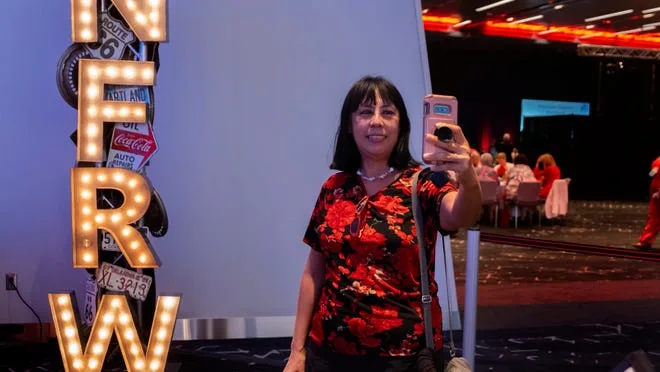The Barbie pink sashes and shirts stood out in the usual sea of red and blue at a Republican women’s convention in Oklahoma City.
While the blockbuster movie that inspired the pink fashion wave was all about equity, these sashes and shirts had a different message. They slammed the rights of trans women.
Some conservatives worry the hardline messaging is hurting the party’s chance of recruiting younger, more diverse voters ahead of the the 2024 presidential election.
“I always say stay away from the polarizing issues, because the polarizing issues are not where the common ground is,” said Maria Sofia, who leads the youth engagement effort of the National Federation of Republican Women, which hosted the Oklahoma City convention that ended this past Sunday.
The decades-old organization has helped push women to the forefront of the GOP. But today, its membership base reflects the party’s broader struggle to gain ground among young, diverse voters. Most women who belong to the group are white, and only a fraction are 45 or younger.
Younger, more diverse generations are beginning to vote in the US
The U.S. electorate has diversified at a much more rapid clip, and those votes could decide close races in battleground states. African American voters turn out at consistent rates, but women from this voting bloc have been shown to swing crucial elections throughout the country, while the number of Hispanic voters is growing faster than any other. Younger, more diverse generations are casting ballots for the first time.
For Sofia and others, the road map to winning them over to the GOP looks like this: Focus on issues that hit close to home, such as rising prices, and steer clear from fierce debates over topics such as gender identity.
The party has to be welcoming to grow, Sofia said. After all, who wants to be part of something combative?
“Arguing, bickering and dividing each other, I think that’s exactly what the Democrats want,” said Sofia, who traveled from Maryland for the convention, which drew more than 1,000 Republican women from across the United States.
More:National Federation of Republican Women meet in OKC for politics and campaign training
About 600 of the women voted in a straw poll conducted at the event. Nearly 60 percent of voters supported former President Donald Trump as their 2024 pick, and the same share agreed the country’s “best years are behind us.”
Organizers did make several nods to their efforts to reach younger crowds: a red, white and blue balloon backdrop stood next to the registration table so women could snap photos for social media. Several vendors set up to sell trendy accessories with a conservative spin; one booth had pistol-shaped, rhinestone-covered purses in at least three colors. One workshop focused specifically on how to better reach younger people.
A common belief held by young adults and teenagers is that the GOP is racist and out-of-touch with modern sensibilities and issues, speakers said during the worksop. Julie Hartman, who hosts a conservative podcast, said the party would be more effective if it shifted its brand messaging and avoided certain words.
“The point of this discussion is to talk about efficacy, so, if we want to be effective, whether we like it or not, we do have to be careful in some ways,” Hartman said.
Examples she gave to avoid included the phrase “illegal alien,” which she said would sound dismissive and insulting of migrants who die crossing the border while trying to flee violence in other countries, and the slogan “abortion is a sin,” which she said would not matter to a person who was not raised in a religious household.
What issues did Republican women say the GOP needs to work on?
The GOP needs to appreciate cultural differences to attract new voters, especially to bring in more people of color, said June Wood, who traveled from Fayetteville, Arkansas, for the convention.
“It has to be an intentional thing all the time, not only election time,” said Wood, who is African American. Her husband, Joseph Wood, recently was tapped to lead the Arkansas Republican Party.
She believes the GOP could focus more on economic issues that affect everyone.
“The normal voter is asking, ‘How am I getting food on my table? How can I pay my bills?’” she said. “It’s all of that. It’s kitchen table issues.”
Education is another touchpoint issue that could bridge demographic divides, Wood and other women said.

The millennials who used to buy coffee from Starbucks every day are now moms wondering how they can afford a house and how they can find the best education for their children, Sofia said. Many are wondering if public school is best or if they should home school instead.
“It’s almost like, what do I believe any more?” Sofia said.
Groups such as Moms for Liberty have built a growing place in national politics by appealing to those personal dilemmas and calling for parental rights. Republican Party leaders in Oklahoma and beyond frequently talk about their efforts to remove “woke ideology” from public schools.
The party also has embraced school choice, or public funding for students to attend private schools. School choice can also draw in more voters because it means opportunities for all families, said Cindy Casaus, who lives in the Phoenix area and leads the Arizona chapter of the NFRW.
“You’ve got folks who live in areas where they may not have the best schools and they should be able to have that choice,” said Casaus, who is Hispanic and Native American.
GOP has a long way to go to attract diverse voters
Casaus said the 2020 election cycle showed the party is actively trying to diversify its voter base, through efforts such as targeted campaigns and voter registration booths.
But the GOP still has a long way to go. In a 2022 survey of Latino voters conducted by the Pew Research Center, 60% said the Republican Party did not represent their interests “well or well at all.”
Emily Lampkin, a Republican political consultant who spoke at a grassroots organizing workshop at the convention, said the party needs to embrace new approaches to reach voters of color and younger women.
Long campaign events in the evening are out, she said. A good event is flexible and can accommodate working mothers with kids.
“You need to expect that somebody is coming from the soccer field,” she said. “Like dropping off a kid. We’ve got to feel like that’s cool.”
Angela Dye, a 38-year-old activist from Washington state, attended the young voter workshop that was happening at the same time. She said said she’d felt she was running out of ideas on how to bolster engagement from young people in a state that has been a Democratic stronghold for decades.
“Avoiding the buzzwords was helpful,” Dye said of the advice. “But this is still very difficult, because we have a lot of stagnant old people, and then me and a few other younger people that want to do other stuff. We’re still working on trying to get more people, but I don’t think we can do things just one way. I think we can embrace our differences.”
Party leaders ultimately need to recognize not everybody is going to agree all the time and stop approaching voter engagement as one-size-fits-all, Wood said.
“You cannot expect for everybody to have checked all the boxes,” Wood said, “and that’s where Republicans have had a hard time.”
Staff writer M. Scott Carter contributed to this report.



